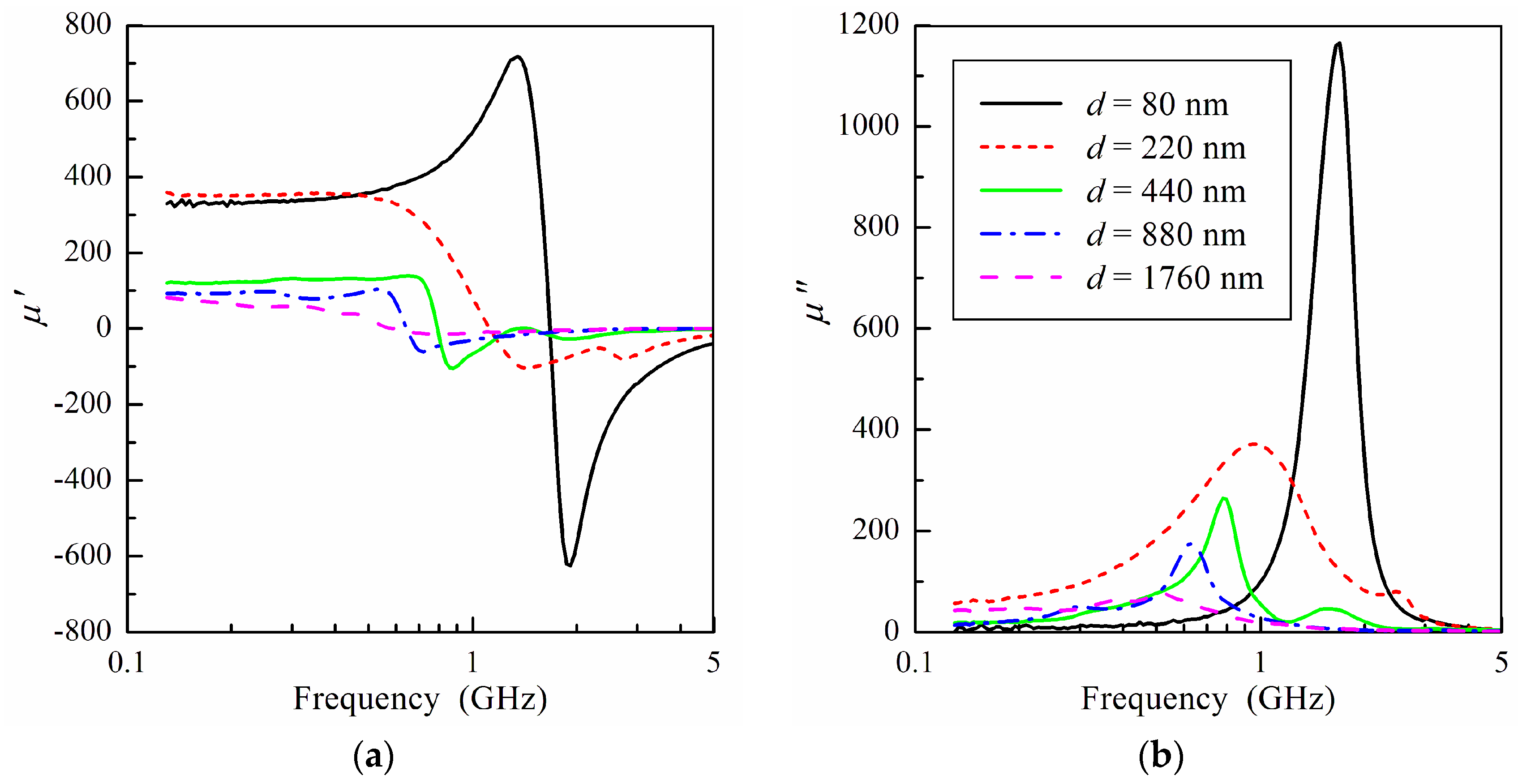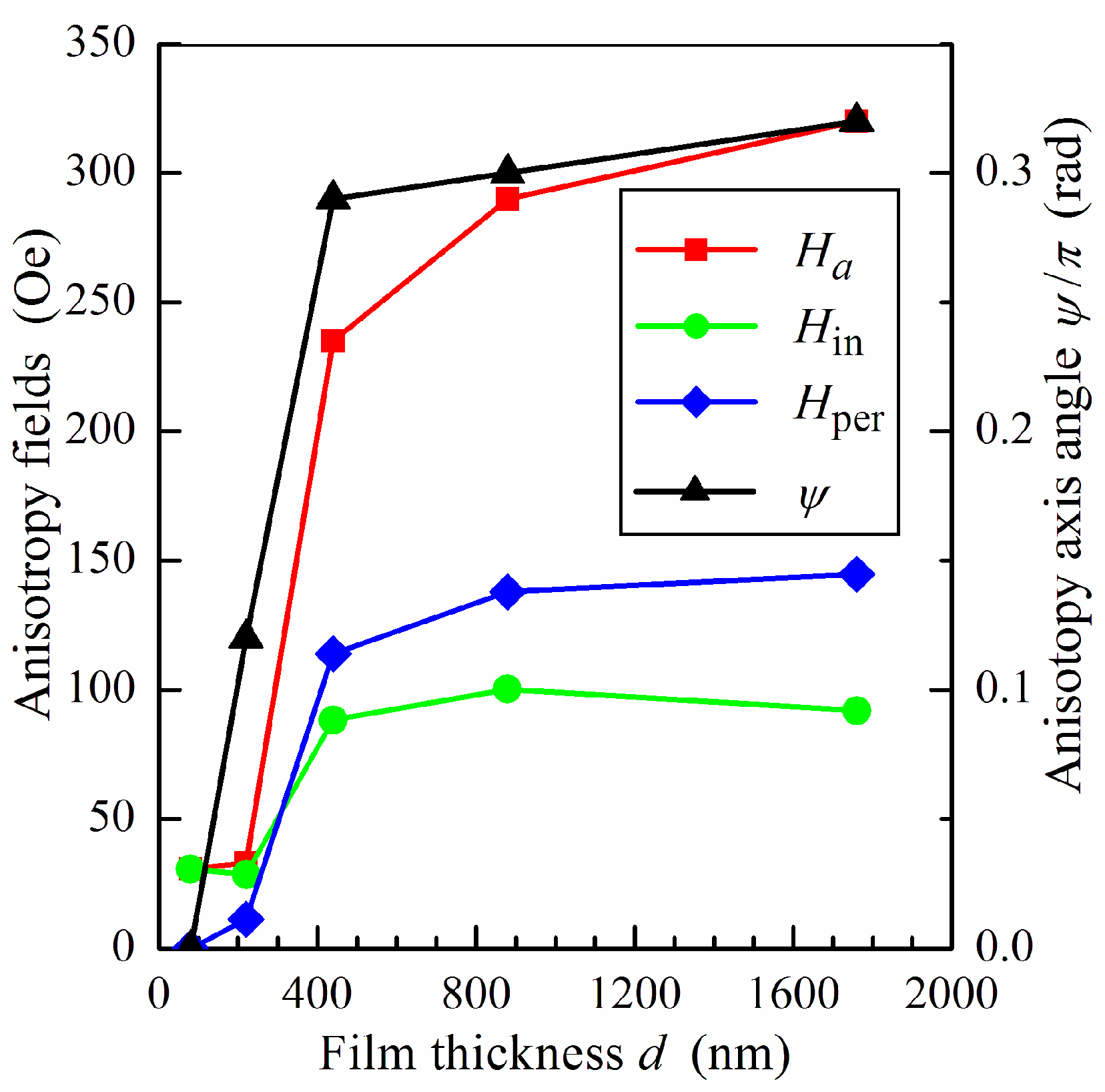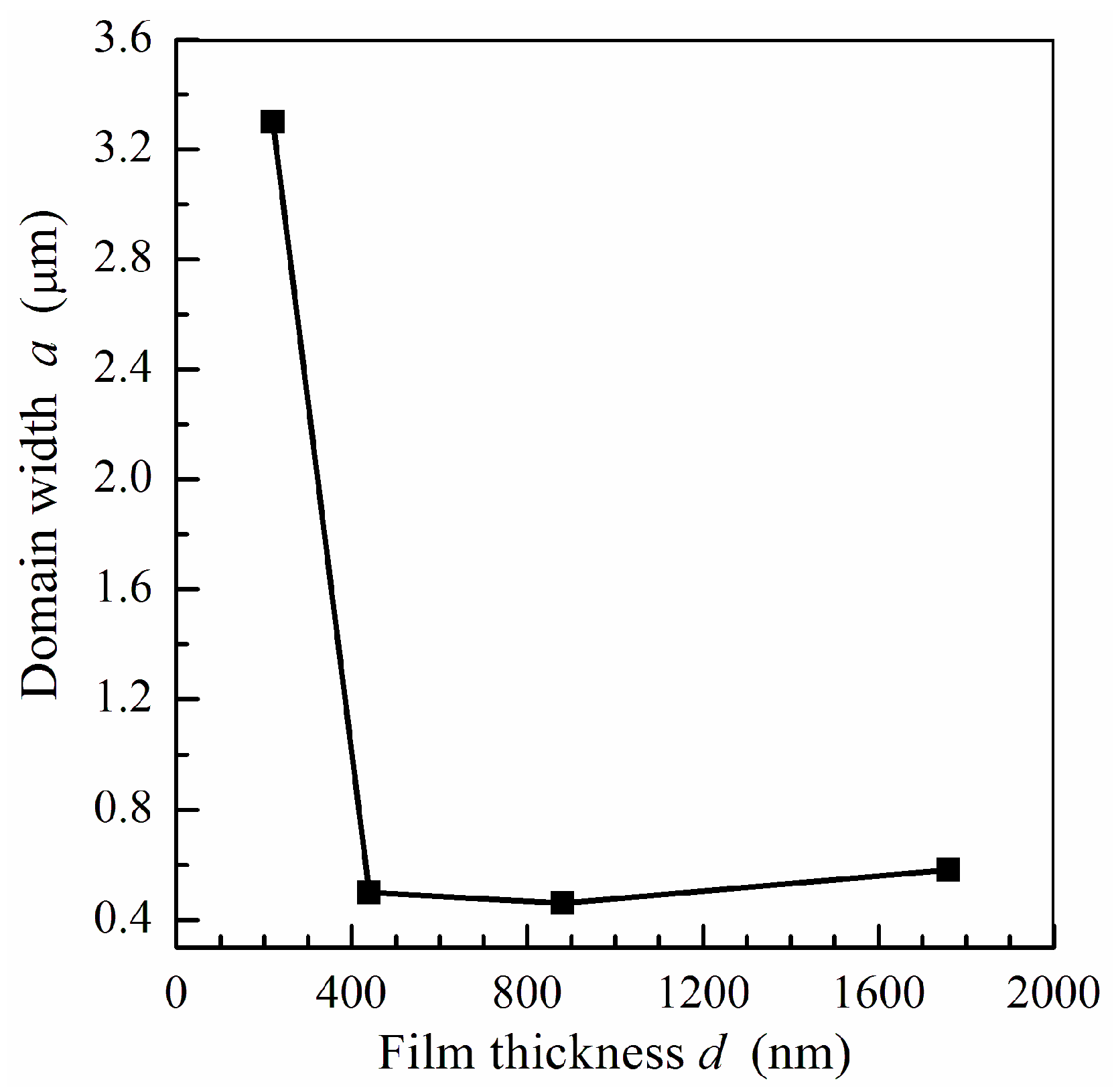Analysis of Relationship between Microwave Magnetic Properties and Magnetic Structure of Permalloy Films
Abstract
:1. Introduction
2. Model
3. Experimental
4. Results and Discussion
5. Conclusions
Author Contributions
Funding
Institutional Review Board Statement
Informed Consent Statement
Data Availability Statement
Conflicts of Interest
References
- Yamaguchi, M.; Suezawa, K.; Takahashi, Y.; Arai, K.I.; Kikuchi, S.; Shimada, Y.; Tanabe, S.; Ito, K. Magnetic thin-film inductors for RF-integrated circuits. J. Magn. Magn. Mater. 2000, 215, 807–810. [Google Scholar] [CrossRef]
- Fergen, I.; Seemann, K.; von der Weth, A.; Shüppen, A. Soft ferromagnetic thin films for high frequency applications. J. Magn. Magn. Mater. 2002, 242–245, 146–151. [Google Scholar] [CrossRef]
- Bekker, V.; Seemann, K.; Leiste, H. Development and optimisation of thin soft ferromagnetic Fe–Co–Ta–N and Fe–Co–Al–N films with in-plane uniaxial anisotropy for HF applications. J. Magn. Magn. Mater. 2006, 296, 37–45. [Google Scholar] [CrossRef]
- Seemann, K.; Leiste, H.; Bekker, V. A new generation of CMOS-compatible high frequency microinductors with ferromagnetic cores: Theory, fabrication and characterization. J. Magn. Magn. Mater. 2006, 302, 321–326. [Google Scholar] [CrossRef]
- Rahman, B.M.F.; Divan, R.; Rosenmann, D.; Wang, T.; Peng, Y.; Wang, G. Application of sub-micrometer patterned permalloy thin film in tunable radio frequency inductors. J. Appl. Phys. 2015, 117, 17C121. [Google Scholar] [CrossRef]
- Wang, T.; Peng, Y.; Jiang, W.; Huang, Y.M.; Rahman, B.M.F.; Divan, R.; Rosenmann, D.; Wang, G. Integrating nanopatterned ferromagnetic and ferroelectric thin films for electrically tunable RF applications. IEEE Trans. Microw. Theory Tech. 2017, 65, 504–512. [Google Scholar] [CrossRef]
- Karilainen, A.O.; Ikonen, P.M.T.; Simovski, C.R.; Tretyakov, S.A. Choosing dielectric or magnetic material to optimize the bandwidth of miniaturized resonant antennas. IEEE Trans. Antennas Propagat. 2011, 59, 3991–3998. [Google Scholar] [CrossRef]
- Huitema, L.; Reveyrand, T.; Mattei, J.-L.; Arnaud, E.; Decroze, C.; Monediere, T. Frequency tunable antenna using a magneto-dielectric material for DVB-H application. IEEE Trans. Antennas Propagat. 2013, 61, 4456–4466. [Google Scholar] [CrossRef]
- Ludwig, A.; Tewes, M.; Glasmachers, S.; Löhndorf, M.; Quandt, E. High-frequency magnetoelastic materials for remote-interrogated stress sensors. J. Magn. Magn. Mater. 2002, 242, 1126–1131. [Google Scholar] [CrossRef]
- Sohn, J.; Han, S.H.; Yamaguchi, M.; Limm, S.H. Tunable electromagnetic noise suppressor integrated with a magnetic thin film. Appl. Phys. Lett. 2006, 89, 103501. [Google Scholar] [CrossRef]
- Park, J.; Lee, J.W.; Choi, H.J.; Jang, W.G.; Kim, T.S.; Suh, D.S.; Jeong, H.Y.; Chang, S.Y.; Roh, J.C.; Yoo, C.S.; et al. Electromagnetic interference shielding effectiveness of sputtered NiFe/Cu multi-layer thin film at high frequencies. Thin Solid Film. 2019, 677, 130–136. [Google Scholar] [CrossRef]
- Snoek, J.L. Dispersion and absorption of magnetic ferrites at frequencies above 1 MHz. Physica 1948, 14, 207–217. [Google Scholar] [CrossRef]
- Perrin, G.; Acher, O.; Peuzin, J.C.; Vucadinovic, N. Sum rules for gyromagnetic permeability of ferromagnetic thin films: Theoretical and experimental results. J. Magn. Magn. Mater. 1996, 157/158, 289–290. [Google Scholar] [CrossRef]
- Acher, O.; Queste, S.; Ledieu, M.; Barholz, K.-U.; Mattheis, R. Hysteretic behavior of the dynamic permeability on a Ni-Fe thin film. Phys. Rev. B 2003, 68, 184414. [Google Scholar] [CrossRef]
- Lagarkov, A.N.; Rozanov, K.N.; Simonov, N.A.; Starostenko, S.N. Microwave permeability of magnetic films. In Handbook of Advanced Magnetic Materials; Liu, Y., Sellmyer, D.J., Shindo, D., Eds.; Springer: Boston, MA, USA, 2006; pp. 1742–1773. [Google Scholar]
- Rozanov, K.N.; Koledintseva, M.Y. Application of generalized Snoek’s law over a finite frequency range: A case study. J. Appl. Phys. 2016, 119, 073901. [Google Scholar] [CrossRef]
- Buznikov, N.A.; Rozanov, K.N. The effect of stripe domain structure on dynamic permeability of thin ferromagnetic films with out-of-plane uniaxial anisotropy. J. Magn. Magn. Mater. 2005, 285, 314–326. [Google Scholar] [CrossRef]
- Zezyulina, P.A.; Iakubov, I.T.; Lagarkov, A.N.; Maklakov, S.A.; Maklakov, S.S.; Naboko, A.S.; Osipov, A.V.; Petrov, D.A.; Rozanov, K.N.; Ryzhikov, I.A. The effect of the perpendicular anisotropy and eddy currents on the microwave performance of single-layer and multi-layer permalloy films. IEEE Magn. Lett. 2016, 7, 3705804. [Google Scholar] [CrossRef]
- Bobrovskii, S.Y.; Iakubov, I.T.; Lagarkov, A.N.; Maklakov, S.A.; Maklakov, S.S.; Osipov, A.V.; Rozanov, K.N.; Ryzhikov, I.A.; Petrov, D.A.; Zezyulina, P.A. Variation of microwave magnetic properties for thin films of ferromagnetic metals with the film thickness. J. Magn. Magn. Mater. 2018, 459, 20–25. [Google Scholar] [CrossRef]
- Ben Youssef, J.; Vukadinovic, N.; Billet, D.; Labrune, M. Thickness-dependent magnetic excitations in permalloy films with nonuniform magnetization. Phys. Rev. B 2004, 69, 174402. [Google Scholar] [CrossRef]
- Dastagir, T.; Xu, W.; Sinha, S.; Wu, H.; Cao, Y.; Yu, H.B. Tuning the permeability of permalloy films for on-chip inductor applications. Appl. Phys. Lett. 2010, 97, 162506. [Google Scholar] [CrossRef]
- Izotov, A.V.; Belyaev, B.A.; Boev, N.M.; Burmitskikh, A.V.; Leksikov, A.A.; Skomorokhov, G.V.; Solovev, P.N. Tailoring the microwave properties of thin Permalloy films using a periodically grooved substrate. Physica B 2022, 629, 413654. [Google Scholar] [CrossRef]
- Li, T.; Wang, Y.; Shi, H.; Xi, L.; Xue, D. Impact of skin effect on permeability of Permalloy films. J. Magn. Magn. Mater. 2022, 545, 168750. [Google Scholar] [CrossRef]
- Jiang, X.; Zhang, J.; Song, X.; Wang, H.; Zhang, K.; He, Z.; Wu, C.; Yu, Z.; Lan, Z.; Sun, K. Tunable resonance frequency of NiFe thin films by oblique deposition. J. Magn. Magn. Mater. 2022, 547, 168946. [Google Scholar] [CrossRef]
- Goldman, S.; Celinski, Z. Magnetic properties of (Ni0.81Fe0.19/SiO2)n multilayers for high frequency on-wafer inductor applications. J. Magn. Magn. Mater. 2023, 569, 170440. [Google Scholar] [CrossRef]
- Kurlyandskaya, G.V.; Fernández, E.; Svalov, A.; Burgoa Beitia, A.; García-Arribas, A.; Larrañaga, A. Flexible thin film magnetoimpedance sensors. J. Magn. Magn. Mater. 2016, 415, 91–96. [Google Scholar] [CrossRef]
- Agra, K.; Mori, T.J.A.; Dorneles, L.S.; Escobar, V.M.; Silva, U.C.; Chesman, C.; Bohn, F.; Corrêa, M.A. Dynamic Magnetic behavior in non-magnetostrictive multilayered films grown on glass and flexible substrates. J. Magn. Magn. Mater. 2014, 355, 136–141. [Google Scholar] [CrossRef]
- Blyakhman, F.A.; Buznikov, N.A.; Sklyar, T.F.; Safronov, A.P.; Golubeva, E.V.; Svalov, A.V.; Sokolov, S.Y.; Melnikov, G.Y.; Orue, I.; Kurlyandskaya, G.V. Mechanical, electrical and magnetic properties of ferrogels with embedded iron oxide nanoparticles obtained by laser target evaporation: Focus on multifunctional biosensor applications. Sensors 2018, 18, 872. [Google Scholar] [CrossRef] [PubMed]
- Melnikov, G.Y.; Lepalovskij, V.N.; Svalov, A.V.; Safronov, A.P.; Kurlyandskaya, G.V. Magnetoimpedance thin film sensor for detecting of stray fields of magnetic particles in blood vessel. Sensors 2021, 21, 3621. [Google Scholar] [CrossRef]
- Sugita, Y.; Fujiwara, H.; Sato, T. Critical thickness and perpendicular anisotropy of evaporated permalloy films with stripe domains. Appl. Phys. Lett. 1967, 10, 229–231. [Google Scholar] [CrossRef]
- Amos, N.; Fernandez, R.; Ikkawi, R.; Lee, B.; Lavrenov, A.; Krichevsky, A.; Litvinov, D.; Khizroev, S. Magnetic force microscopy study of magnetic stripe domains in sputter deposited Permalloy thin films. J. Appl. Phys. 2008, 103, 07E732. [Google Scholar] [CrossRef]
- Svalov, A.V.; Aseguinolaza, I.R.; Garcia-Arribas, A.; Barandiaran, J.M.; Alonso, J.; Fernández-Gubieda, M.L.; Orue, I.; Kurlyandskaya, G.V. Structure and magnetic properties of thin Permalloy films near the transcritical state. IEEE Trans. Magn. 2010, 46, 333–336. [Google Scholar] [CrossRef]
- Cao, D.; Wang, Z.; Feng, E.; Wei, J.; Wang, J.; Liu, Q. Magnetic properties and microstructure investigation of electrodeposited FeNi/ITO films with different thickness. J. Alloys Compd. 2013, 581, 66–70. [Google Scholar] [CrossRef]
- Silva, E.F.; Corrêa, M.A.; Della Pace, R.D.; Plá Cid, C.C.; Kern, P.R.; Carara, M.; Chesman, C.; Alves Santos, O.; Rodríguez-Suárez, R.L.; Azevedo, A.; et al. Thickness dependence of the magnetic anisotropy and dynamic magnetic response of ferromagnetic NiFe films. J. Phys. D Appl. Phys. 2017, 50, 185001. [Google Scholar] [CrossRef]
- De Melo, A.S.; Bohn, F.; Ferreira, A.; Vaz, F.; Correa, M.A. High-frequency magnetoimpedance effect in meander-line trilayered films. J. Magn. Magn. Mater. 2020, 515, 167166. [Google Scholar] [CrossRef]
- Raj, R.; Kuila, M.; Gupta, M.; Reddy, V.R. 57Fe Mössbauer and magneto-optical Kerr effect (MOKE) study of transcritical state in permalloy (FexNi100-x) thin films. Hyperfine Interact. 2021, 242, 30. [Google Scholar] [CrossRef]
- Komogortsev, S.V.; Vazhenina, I.G.; Kleshnina, S.A.; Iskhakov, R.S.; Lepalovskij, V.N.; Pasynkova, A.A.; Svalov, A.V. Advanced characterization of FeNi-based films for the development of magnetic field sensors with tailored functional parameters. Sensors 2022, 22, 3324. [Google Scholar] [CrossRef] [PubMed]
- Cotón, N.; Andrés, J.P.; Molina, E.; Jaafar, M.; Ranchal, R. Stripe domains in electrodeposited Ni90Fe10 thin films. J. Magn. Magn. Mater. 2023, 565, 170246. [Google Scholar] [CrossRef]
- Coïsson, M.; Vinai, F.; Tiberto, P.; Celegato, F. Magnetic properties of FeSiB thin films displaying stripe domains. J. Magn. Magn. Mater. 2009, 321, 806–809. [Google Scholar] [CrossRef]
- Marty, A.; Samson, Y.; Gilles, B.; Belakhovsky, M.; Dudzik, E.; Dürr, H.; Dhesi, S.S.; van der Laan, G.; Goedkoop, J.B. Weak-stripe magnetic domain evolution with an in-plane field in epitaxial FePd thin films: Model versus experimental results. J. Appl. Phys. 2000, 87, 5472–5474. [Google Scholar] [CrossRef]
- Vukadinovic, N.; Vacus, O.; Labrune, M.; Acher, O.; Pain, D. Magnetic excitations in a weak-stripe-domain structure: A 2D dynamic micromagnetic approach. Phys. Rev. Lett. 2000, 85, 2817–2820. [Google Scholar] [CrossRef]
- Sallica Leva, E.; Valente, R.; Martínez Tabares, F.; Vásquez Mansilla, M.; Roshdestwensky, S.; Butera, A. Magnetic domain crossover in FePt thin films. Phys. Rev. B 2010, 82, 144410. [Google Scholar] [CrossRef]
- Kaczer, J.; Murtinova, L. On the demagnetizing energy of periodic magnetic distributions. Phys. Stat. Solidi A 1974, 23, 79–86. [Google Scholar] [CrossRef]
- Ramesh, M.; Ren, E.W.; Artman, J.O.; Kryder, M.H. Domain mode ferromagnetic resonance studies in bismuth-substituted magnetic garnet films. J. Appl. Phys. 1988, 64, 5483–5485. [Google Scholar] [CrossRef]
- Vukadinovic, N.; Ben Youssef, J.; Le Gall, H. Influence of magnetic parameters on microwave absorption of domain mode ferromagnetic resonance. J. Magn. Magn. Mater. 1995, 150, 213–222. [Google Scholar] [CrossRef]
- Rozanov, K.N.; Simonov, N.A.; Osipov, A.V. Microwave measurements of the magnetic film permeability. J. Commun. Technol. Electron. 2002, 47, 210–216. [Google Scholar]
- Iakubov, I.T.; Kashurkin, O.Y.; Lagarkov, A.N.; Maklakov, S.A.; Osipov, A.V.; Rozanov, K.N.; Ryzhikov, I.A.; Starostenko, S.N. A contribution from the magnetoelastic effect to measured microwave permeability of thin ferromagnetic films. J. Magn. Magn. Mater. 2012, 324, 3385–3388. [Google Scholar] [CrossRef]
- Hristoforou, E.; Ktena, A.; Angelopoulos, S. Magnetostrictive materials for sensing applications. In Encyclopedia of Smart Materials; Olab, A.-G., Ed.; Springer: Amsterdam, The Netherlands, 2022; Volume 15, pp. 355–365. [Google Scholar]
- Munakata, M.; Namikawa, M.; Motoyama, M.; Yagi, M.; Shimada, Y.; Yamaguchi, M.; Arai, K.I. Magnetic properties and frequency characteristics of (CoFeB)x–(Si01.9)1–x and CoFeB films for RF applications. Trans. Magn. Soc. Japan 2002, 2, 388–393. [Google Scholar] [CrossRef]
- Wang, G.; Dong, C.; Wang, W.; Wang, Z.; Chai, G.; Jiang, C.; Xue, D. Observation of rotatable stripe domain in permalloy films with oblique sputtering. J. Appl. Phys. 2012, 112, 093907. [Google Scholar] [CrossRef]
- Liu, M.; Li, Q.; Song, C.; Feng, H.; Son, Y.; Zhong, L.; Pan, L.; Zhao, C.; Li, Q.; Xu, J.; et al. Microwave excitations and hysteretic magnetization dynamics of stripe domain films. J. Magn. Magn. Mater. 2022, 547, 168939. [Google Scholar] [CrossRef]






Disclaimer/Publisher’s Note: The statements, opinions and data contained in all publications are solely those of the individual author(s) and contributor(s) and not of MDPI and/or the editor(s). MDPI and/or the editor(s) disclaim responsibility for any injury to people or property resulting from any ideas, methods, instructions or products referred to in the content. |
© 2024 by the authors. Licensee MDPI, Basel, Switzerland. This article is an open access article distributed under the terms and conditions of the Creative Commons Attribution (CC BY) license (https://creativecommons.org/licenses/by/4.0/).
Share and Cite
Buznikov, N.A.; Lagarkov, A.N.; Maklakov, S.A.; Maklakov, S.S.; Osipov, A.V.; Rozanov, K.N.; Zezyulina, P.A. Analysis of Relationship between Microwave Magnetic Properties and Magnetic Structure of Permalloy Films. Sensors 2024, 24, 6165. https://doi.org/10.3390/s24196165
Buznikov NA, Lagarkov AN, Maklakov SA, Maklakov SS, Osipov AV, Rozanov KN, Zezyulina PA. Analysis of Relationship between Microwave Magnetic Properties and Magnetic Structure of Permalloy Films. Sensors. 2024; 24(19):6165. https://doi.org/10.3390/s24196165
Chicago/Turabian StyleBuznikov, Nikita A., Andrey N. Lagarkov, Sergey A. Maklakov, Sergey S. Maklakov, Alexey V. Osipov, Konstantin N. Rozanov, and Polina A. Zezyulina. 2024. "Analysis of Relationship between Microwave Magnetic Properties and Magnetic Structure of Permalloy Films" Sensors 24, no. 19: 6165. https://doi.org/10.3390/s24196165





